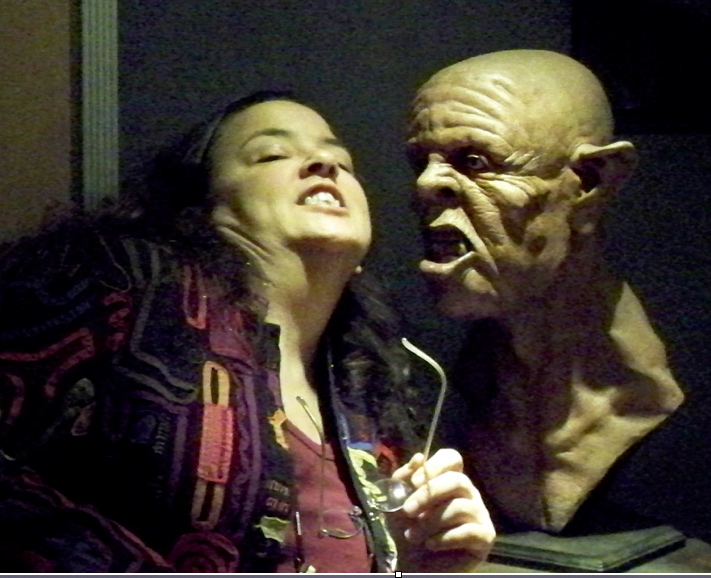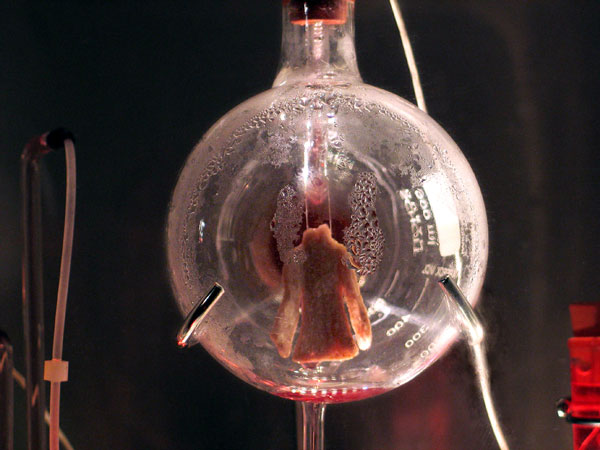3D
A New Book—A Resource Book For Those Creating Physical Objects Using 3D Technology!
I’m working on a new book
Tra-digi-2014 Sculpture:
Using 3d software, milling, scanning and printing in art and craft.
At least that is what the book is called at this moment.
A single source for incorporating 3D printing, 3D scanning and 3D milling into your art.
Tra-digi 2014—Sculpture: How to use 3D printing, milling and scanning in art and craft
- Do you want a 3D model of your child for your computer? Here is how to do it for free.
- Do you want to take a virtual sculpture and make it into a 3D print in clay, metal or even glass? Here are the steps, tools and resources to do just that.
- Have you thought of carving your ideas into wood, or stone but you can’t hold a hammer and mallet?
- Do you want to take a small sculpture made by hand and enlarge it to a monumental piece of art?
- Would you like to have a digital scan of your surroundings?
With the steps in Tra-digi 2014-Sculpture you can expand your medium as an artist, save yourself time in the traditional bronze casting and enlarging process. This give you more time to create!
But beware, there are some pitfalls, some hurtles and legalities associated with using traditional and digital processes. Learn how to protect yourself and your art as you create new masterpieces that could never be created before.
Bridgette Mongeon is a sculptor, writer, illustrator and educator as well as a public speaker.
Her blog can be found at https://creativesculpture.com.
She is the vice chair of the planning committee for 3DCAMP Houston 2012 http://www.3dcamphouston.com
She is also the owner and creator of the God’s Word Collectible Sculpture series http://www.godsword.net
Follow the artists on twitter twitter.com/Sculptorwriter and twitter.com/creategodsword
Listen to The Creative Christian Podcast or the Inspiration/Generation Podcast
Click on Podcast Host Bios for a list of all podcasts.
CNC Milling And CarveWright Conference
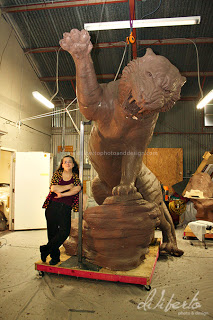
I could have done it without the use of CNC
milling. Oh yes, please note there is another
3 foot of rock that goes under this sculpture.
I have been compiling information and resources for a book that I am writing that talks about incorporating digital and traditional process in art. I call this marriage of the two -Tradigi art. I have been trying to educate others on the process of using 3D technology for a few years. Mike de la Flor and I wrote Digital Sculpting With Mudbox Essential Tools and Techniques and spent a chapter talking about 3D scanning, printing and milling. Our book, I believe, was one of the first that talks about how to get virtual pieces out of the computer and into a physical form. When I first started to do this, many CG people would ask, “Why do you want to get your designs out of the computer?” These are people who use the computer generated designs in movies, video, gaming etc. Without bringing virtual pieces into a physical world my designs are pretty much worthless to me.
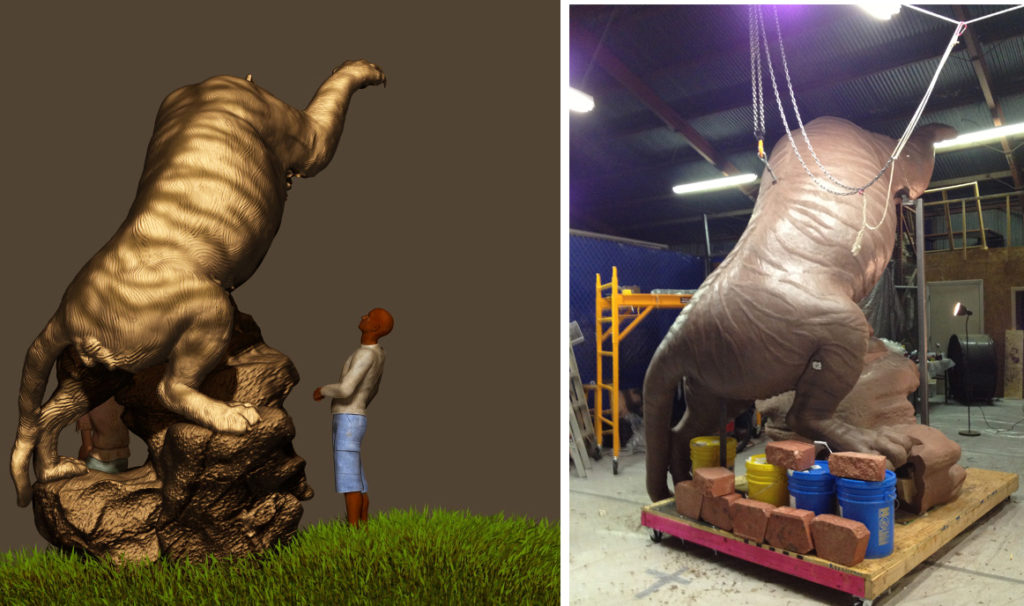
created in the computer and the milled out foam
covered with a fine layer of clay.
Once the client approves the clay the sculpture
is taken into the lost wax method of bronze casting.
I am inspired to educate others on how to do these things and the possibilities of incorporating this type of work into their traditional studios. Here is a pdf of a 2008 article in Sculptural Review that I wrote about the process of CNC milling in art.
I have been using CNC milling of foam for a few years now. My two primary vendors are Synappsys in Oklahoma and Across the Board Creations in Canada. I have described some of my processes in a You tube video on the subject. I also have project blogs for the last several projects that talk about using the CNC milling of foam with my designs. I used CNC Milling on the Prairie View Panther, the Evelyn Rubenstein Sculpture for the Jewish Community Center and most recently on this enormous sculpture of the Tiger for Grambling State University.
I have also watched in fascination and excitement about the CNC Milling in Stone. All of these tools expand my tool set and save a sculptor’s hands from very damaging wear and tear.
Steven Ramirez of Smash Designs introduced me to the CarveWright . He was one of our speakers last year at 3DCAMP Houston. Once I saw the CarveWright and it’s possibilities I was very, very intrigued. I had been looking for a vendor that might mill my work. I’m still looking for this type of vendor. I had also been searching for others who had been using CNC milling in their artwork. I wanted to feature them in the book, and yes, I am entertaining getting a CarveWright of my own.
3DCAMP is a 3D symposium on everything 3D. It is hosted this year by the department of Architecture at the University of Houston. The date is October 5, 2013. The cost last year was only $15. and this year will be raised to $30 for professionals and $15 for students. A great prices for so much information and resources in one space. We had hoped that CarveWright might be a sponsor for last years 3DCAMP event, and would be able to discuss more about milling at 3DCAMP.
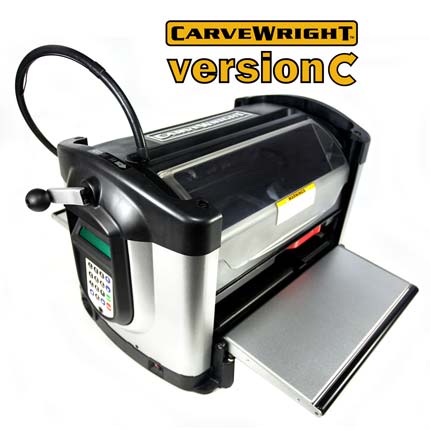
What is a CarveWright? It is an affordable consumer CNC milling machine that gives you the opportunity to design your own patterns, or use patterns provided with the machine and mill them out in many different materials. When learning about the CarveWright Conference, I was intrigued, not only because of my desire to try this machine, but also because I really wanted to gather more information for the book.
I learned many things from attending the CarveWright conference and was intrigued by the many people that I met. Of course, I’m looking at this tool and thinking, how can I push it like no one has ever pushed it before. How can I sculpt using this tool? I’m not the only one thinking about pushing the boundaries as Joe Lovchik, one of the owners of CarveWright was displaying how to use the tool to not only carve wood, but carve other things like foam, plastic and even wax. He showed how he used the CarveWright to make a pattern for pouring concrete, stamping leather, creating incredible lithophanes. The possibilities really made your head spin.

Besides learning the software that comes with the program, some of which I hear is some of the best for CNC milling, we heard what others were doing with the CarveWright. Michael Tyler displayed some of his creations and talked about inspiration. I loved learning about the stains and patinas he is using called Sculpture Nouveau. They are breathtaking! Joe Ragsdale talked about carving photos in wood. The feature that I think would be easily applicable to my own studio process is the carving of letters. I often get asked to incorporate type into my sculptures. This is not an easy task and takes a great deal of handwork. For example, the newspaper that the newsboy holds has copy that is individualized for each client that purchases this bronze. I have to change out the headline and subhead so that it is pertinent to those who are purchasing this bronze. You can be sure that the next time this happens I’ll be scanning this newspaper and carving it with a CarveWright. Oh, yes, I failed to mention, the CarveWright has a point scanner that you can purchase as well.
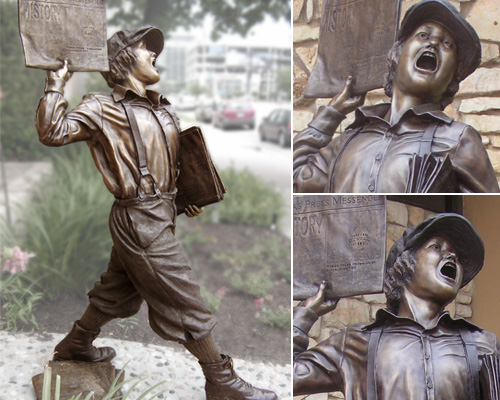
The possibilities and relationship between me and CNC and me and CarveWright are just beginning. I hope they will help me to push the limits of their product with my designs and look forward to working with them on this. I can’t wait to see what I come up with for the book. My head is already thinking in that strange 3D way. Thanks CarveWright for the information and the inspiration.
_______________________________________________
Bridgette Mongeon is a sculptor, writer, illustrator and educator as well as a public speaker.
Her blog can be found at https://creativesculpture.com.
She is the vice chair of the planning committee for 3DCAMP Houston 2012 http://www.3dcamphouston.com
She is also the owner and creator of the God’s Word Collectible Sculpture series http://www.godsword.net
Follow the artists on twitter twitter.com/Sculptorwriter and twitter.com/creategodsword
Listen to The Creative Christian Podcast or the Inspiration/Generation Podcast
Click on Podcast Host Bios for a list of all podcasts.
I Really Need A Measuring Tape in ZBrush or Mudbox
When I started in ZBrush and Mudbox years ago, the computer graphics world ( CG) would often say, “Why do you want to get things out of the computer?” I felt like I was just told I had purple spots on my face. I am a traditional sculptor who uses digital process to create sculpture in the physical form. I have a variety of things that I do that incorporate both traditional and digital or what I call tra-digi art. I know my use of these digital processes is not the way others use them, but it is how I make my living. Oh, and by the way, if you ever want to bring me in to lecture on this subject I would be happy to do so.
When I was at the ZBrush booth at SIGGRAPH last year I saw that someone mentioned that others were translating their designs into the real world. So, I’m not alone.
PIXOLOGIC>>>>GIVE ME A MEASURING TAPE.. PLEASE!
Over the years I have found one thing is a constant – I need a measuring tape! The hard part about this is that in the computer your sculpture is not really any size. It lives in a virtual world with virtual coordinates. However, to get this virtual sculpture to live in a real world I need to compare it to the real world. Over the years this problem has come up again and again.
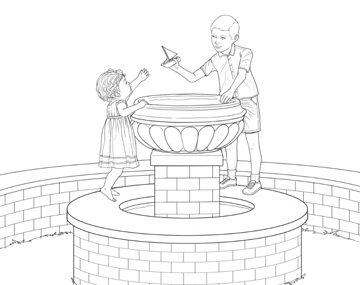
I would still need to create this digitally.
PRESENTATIONS- Comparison to what is there.
This usually happens when I’m working out the design, For example the landscape architect gives me blue prints and I need to come up with something. In the case of the fountain I could go and take pictures of what was created on the job site. The client wanted two children, and I was to incorporate the fountain base, and another piece that would sit on top. I would have loved to create this in ZBrush, but I opted for a simple sketch because of the limitations of measuring.
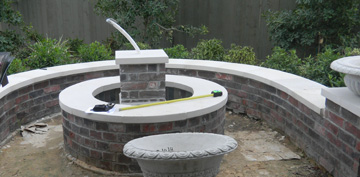
CAN I SHIP IT?
I know that someone working in the computer may not be thinking about shipping their final product. But I ship bronze sculptures all of the time. In many cases this is something I work out in the design process. If I can figure out how to modify the sculpture sometimes, it can save thousands of dollars. For example, I modified the design of the floor of the sculpture of the praying man to be able to fit the width of my van and still be life-size. I was able to do this in the sculpting process when in my traditional studio but there are other times I need this as well. Shipping the Tiger sculpture from my studio in Houston, Texas to Louisiana is a massive investment 7,000- 10,000. The tiger will have to ship on its side. However, I need to be sure that it can do so and fit on the flat bed trailer with packing.
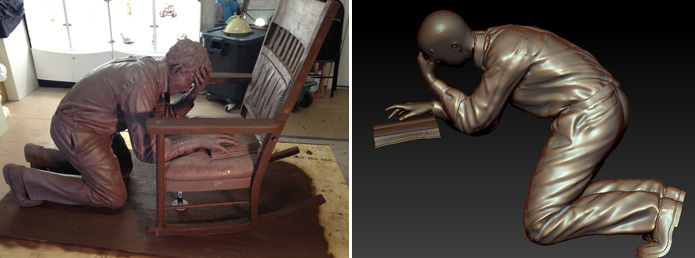
MILLING?
Most of my sculptures, once created and revised in the computer are enlarged digitally in foam. This takes the place of doing the traditional armature of welding and pointing up as done in the past. Synappsys Digital Services does most of my enlarging. They figure out the mass if I give them the height, but it is often necessary to figure measurements out in the design. In
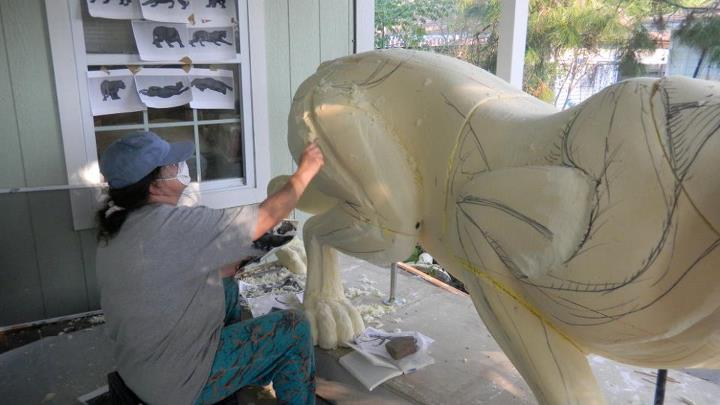
Often in the design stage it would help to be able to say, if it is this height,
what is the width at this place in the sculpture.
the case of the Tiger sculpture I lowered the head and the arm of the tiger, mostly because I could not find a warehouse big enough to allow me to sculpt that size piece. Subtracting a foot, by lowering the hand/head helped the design, but also give me a little more room to work. I would not have known to do that had I not measured in advance.
ARMATURE?
I’m taking time to write this post as I work diligently on trying to figure out the armature for the 13+ foot tiger. Though I can twirl the image around in my computer by pressing certain keys, in the real world this sculpture will have gravity and weight to deal with. The foam of the tiger, once togther will probably weight about 170 lbs. Then we add a layer of wax and a fine layer of clay. This will probably add about 400+ lbs to the tiger alone. Having the proper armature to hold this tiger up is imperative. Without it I could have the entire thing fall and, God forbid, be under it when it does. If I had a measuring tape in zbrush I could be making a schematic for my carpenter to build my base and armatures. I am also looking at a way to create the sculpture separately cutting the pieces in 1/2 so that I don’ t have to carve 15 feet in the air. Oh I wish I had a measuring tape.
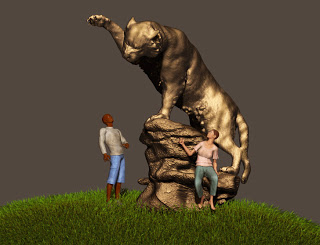
Work around.
Yes there are probably ways to work around this. For example, I know the man in the scene if 6 feet, I can make a long flat piece that measures 6 feet and work with that. But being able to give one element a size, the man is 6 feet—and then able to click anywhere else on the sculpture to see what that size is in relation to the given size of the man- this would make my life a lot easier. So how about it Pixologic? Can I please have a measuring tape in the next version?
These are only a quick few ways I can see that having a measuring tape in a program like ZBrush or Mudbox would really help my work flow, and might even help to extend the buyers of these programs. In my speaking engagements I often tell my audience that I turned to the use of digital tools to extend my career. Pushing around clay with my hands has caused some great aches and pains over the years. Most of my audience wants to learn these processes as well, for just these reasons. Please give a listen Pixologic and Autodesk lets see how you measure up!
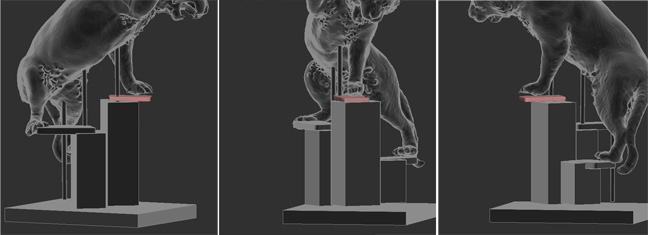
_______________________________________________

Bridgette Mongeon is a sculptor, writer, illustrator and educator as well as a public speaker.
Her blog can be found at https://creativesculpture.com.
She is the vice chair of the planning committee for 3DCAMP Houston 2012 http://www.3dcamphouston.com
She is also the owner and creator of the God’s Word Collectible Sculpture series http://www.godsword.net
Follow the artists on twitter twitter.com/Sculptorwriter and twitter.com/creategodsword
Listen to The Creative Christian Podcast or the Inspiration/Generation Podcast
Click on Podcast Host Bios for a list of all podcasts.
Back To A Panther Sculpture
I have recently been asked about the possibilities of taking the panther that I created for Prairie View A & M and making it into a smaller version or perhaps even jewelry. Of course the traditional process of sculpting a smaller version of the panther is always possible. But that process means a mold and casting and as a table top version the cost of this process can run a couple thousand dollars. I’m open to exploring other options.
With the melding of digital technology in my traditional sculpture studio optional technology is definitely a possibility that I am curious to explore. If you follow the blog on the Panther Project you know that the original panther design was created in the computer, and enlarged by SNYAPPSYS Digital services in foam. Clay was added to the foam for the final version. It was then put through the traditional mold making process for bronze casting.
This digital process of enlarging expedites my work tremendously. The difficulty is that digital models, as seen in the computer, rarely translate well to real life. There were many modifications that I did on the large panther. As the blog shows, I carved on the foam, accentuated muscles and features so that it would translate well into bronze and in some places even lengthened or added to the figure. I also modified the pose.
So, I’m back to the digital drawing board. I am opening the original file of the panther and comparing it to my traditional bronze piece. My goal will be to do more work on the digital version and experiment with printing it using the 3D printing process.
The program that I am sculpting in is ZBrush. I’m exploring the new features that are available in Zbrush 4R4 that were not available when I created the panther just a year ago. Features like QRemesher that helps me to retopologize the panther, or fix the geometry, so that I can create a better digital sculpture. I’ll report back on how the digital sculpting progresses, as well as how the 3D printing process comes along.
Project blog for the Prairie View Panther can be found at https://prairieviewpanther.blogspot.com/
A Wonderful Lecture- From Fabric to Frankenstein- Thanks For Asking Me To Speak
Thank you to Archway Gallery and the ladies of 3-D Arts Houston for asking me to present Bridging the Gap Between Digital and Traditional Sculpture – Fabric to Frankenstein.
For those of you not familiar -this topic discusses how artists are using digital technology in their traditional art processes. I talk about how I use it in my sculpting studio and how other artists around the world are using the technology. There is a lot of basics, but also a lot of information in this lecture. We end the lecture talking a little bit about the ethics of 3D technology especially as it pertains to regenerative medicine and how one artist has brought this to other people’s attention through what I refer to as Frankenstenien art. The lecture also focuses on more than technology and art, but also on the psychology behind how a traditional artist embraces the new technology, ownership and other points of interest. I especially like having so many different artist featured in the lecture. I’m always looking for new artwork from artists using the technology. So even though I will repeat this lecture elsewhere, don’t be surprised if you find it contains more artwork from more artists.
The presentation at Archway was a small group, and a bit different from presenting that same lecture at 3DCAMP Houston while also acting as Vice Chairwoman of the event. Needless to say, I was very relaxed and loved presenting in an atmosphere of art and with such an intimate group of creative people. Our group and space at Archway allowed us the opportunity to have an informal discussion on some of the topics. I was glad that the group left with their brains spinning and a bit dazed at the amount and type information presented. I did my job. I was also excited to be able to hint at another topic that I have spoken on before about the sculpting of the deceased and the undergraduate research that I did that explained the science behind what some refer to as psychic. How do we have an emotional reaction to a piece of art? That is what that topic explains. It also talks about the unusual things that transpire around such commissions. I guess between the two topics it was very appropriate for the month of October. Maybe they will ask me back to talk about that topic.
This morning I received a notice from one of the the members of 3-D Artists Houston group.
Hi Bridgette,
Thank you so much for coming to speak to our 3-D Arts Houston group at Archway last night. We were a smallish but very interested group. I think you opened many eyes and minds to new, fantastic and wonderous things. If they are like me these new ideas incorporating technological tools will be rushing around in their brains for weeks. This happened to me after your first talk years ago at Lone Star Art Guild and again after 3-D camp and my visit to TxRx labs.The new fabrication processes you explained are like a whole new toolbox for creating. I have to learn to use the 3-d modelling tools! We appreciate that you took time out of a super busy week to make your presentation to us. It was a great success with our members. Thank you for sharing your artwork and very bright intellect with us.
Cheers,
Artist Cindy Rasche
For those of you who did attend the lecture I have added my notes in another blog post.
This lecture is great for many different groups, artists, sculptor, those working in 3D or those wanting to learn more about technology. If you are interested in having me present at your group on this topic of any of the other topics I speak on, please feel free to contact me.
_______________________________________________
Bridgette Mongeon is a sculptor, writer, illustrator and educator as well as a public speaker.
Her blog can be found at https://creativesculpture.com.
She is the vice chair of the planning committee for 3DCAMP Houston 2012 http://www.3dcamphouston.com
She is also the owner and creator of the God’s Word Collectible Sculpture series http://www.godsword.net
Follow the artists on twitter twitter.com/Sculptorwriter and twitter.com/creategodsword
Listen to The Creative Christian Podcast or the Inspiration/Generation Podcast
Click on Podcast Host Bios for a list of all podcasts.
A Replay of my Lecture at 3DCAMP at Archway Gallery

Some of you may have missed the incredible experience of 3DCAMP on September 29th at the University of Houston campus. I cannot recreate the entire experience of 3DCAMP Houston 2012, as it was very amazing, however, I have been asked by 3-D Arts Houston group to come to present the lecture Bridging the Gap Between Digital and Traditional Sculpture – Fabric to Frankenstein at Archway Gallery 2305 Dunlavy St. Houston, TX 77006 on October 17th . Wine and snacks will be served at 6:00 with the presentation lasting until 7:30.
_______________________________________________
Bridgette Mongeon is a sculptor, writer, illustrator and educator as well as a public speaker.
Her blog can be found at https://creativesculpture.com.
She is the vice chair of the planning committee for 3DCAMP Houston 2012 http://www.3dcamphouston.com
She is also the owner and creator of the God’s Word Collectible Sculpture series http://www.godsword.net
Follow the artists on twitter twitter.com/Sculptorwriter and twitter.com/creategodsword
Listen to The Creative Christian Podcast or the Inspiration/Generation Podcast
Click on Podcast Host Bios for a list of all podcasts.
Notes From Bridgette Mongeon’s Lecture at 3DCAMP Houston 2012
Thanks to everyone who attended my lecture at 3DCAMP- Bridging the Gap Between the Digital and Traditional Studio and Fabric to Frankenstein.
I really enjoyed presenting and interacting with all of the attendees.
In my lecture I spoke about a few different things. I thought I would list them with links in case anyone wanted to have further information.
- I spoke a bit about my process of using 3D and how I got involved. I covered my use of Poser, Daz , Mudbox and ZBrush in my presentations and then in obtaining enlargements that were milled with a CNC machine in foam. I have a YouTube video on this, should anyone be interested. It is on my YouTube channel and called Digital Art For the Traditional Sculpture Studio
- I also showed another video in the lecture that demonstrated quick sketches in Mudbox.
- If anyone is interested in some of those processes I have several special project blogs where I document my work. For example:
Project Blog-Evelyn Rubenstein
Project Blog- Prairie View Panther
Project Blog-Grambling State Tiger
- I talked about Data Direct to Mold from Synappsys Digital Services. Here is a pdf of an article that I wrote for Sculpture Review that talks about that process and the digital technology and the work on the large sculpture by Shan Gray called “The American.”
- There are several links to information on the work created by Hauer and the reproductions of his panels in this article: Reviewing Technology at the SIGGRAPH Convention.
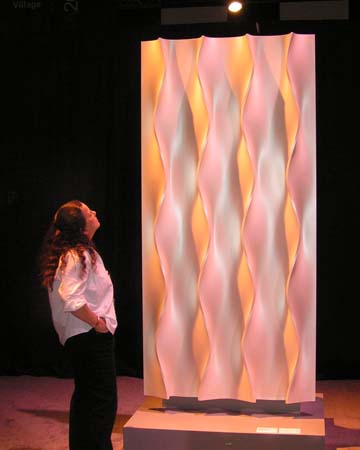
- The Mudbox book that I wrote with Mike de la Flor is called Digital Sculpting in Mudbox: Essential Tools and Techniques for Artists.
- I also mentioned about ethics and digital process and spoke about the Frankenstenian art. I have several posts about that, but I would suggest you listen to the podcast that I did with Oron Catts. You can find the link to the podcast in this blog post titled A discussion on living art with sculptor Oron Catts. You will find a link to the podcast that I recorded with him in this blog post. It is fascinating. Here is another article I wrote titled Frankensteinian Art.
- The video that was playing in the conference room that also impressed me on regenerative medicine is with Gabor Forgacs. It can be found on You Tube. It is what I found a few years back when I asked myself the question, ” if you can shove anything through a 3d printer…?”
- The book I referred to in the lecture is The Immortal Life of Henrietta Lacks. The authors website has a lot of information about ethics as it pertains to human subjects.
- The school that I am so impressed with that does 3d printing in ceramics is Solheim Laboratories. There was an article about them in the Ceramic Arts Daily. I forgot to mention that several hackers are working on extruders that can be added to the home made printer the the rep rap machine.
- I also spoke about ownership. I should probably write an article about ownership as it pertains to the psychological process of transferring from traditional sculpting to digital. I don’t have one yet. I do, however, have some works on the copyright issues. Antiquities, Masterpieces, Rights of Ownership and 3D Scanning is an article I wrote, but I did not get to talk about this in the lecture. I’m including it here because it intrigues me.
- I also mentioned about 3D and copyrights. I did podcast about that with Kevin Gillespie and that can be found in this blog post. All of the Art and Technology podcasts can be found at DigitalSculpting.net.
- There are several companies that can “Get your work out of the computer.” The company that does my CNC milling is Synappsys Digital Services. They are in Oklahoma. I will however be pricing my work out with Steve at Smash Designs because he is local and I just discovered he offers these services
- There are several companies that create work from the computer. I mentioned my favorite was imaterialize. I think because I podcasted with Joris Debois and because they come from .mgx which does such quality work. FYI I think that .mgx is working in the largest build envelope (size) of rapid prototyping. They are also working with foundries in American to create a new sort of process. You all saw Kraftwurx at the conference and there is Shapeways as well.
- For information on stone CNC milling check out the Digital Stone Project. There is also a service bureau that stemmed from the Digital Stone Project. I’ll include it once they contact me. While I was e-mailing them I asked them for a podcast interview- stay tuned.
- Some of the artists I talked about were Robert Lazarini- skull and phone booth – optical illusion, Nathalie Miebach- weaving data, David Beck- gps of friends, David VanNess- 3dprinting multiple pieces, Caleb Weintraub- cnc milling of large figures and adding stuff to it. Eric Van Straaten 3d printed fine art a bit risque, Stelarc- freaky guy with ear on his arm, Orron Catts – coat of skin- see interview and above.
- If I think of any more I’ll let you know.
Thanks once again for coming to my lecture and also for supporting 3DCAMP Houston 2012. If you know of anyone who would like me to speak on these topics or others please feel free to contact me.
_______________________________________________
Bridgette Mongeon is a sculptor, writer, illustrator and educator as well as a public speaker.
Her blog can be found at https://creativesculpture.com.
She is the vice chair of the planning committee for 3DCAMP Houston 2012 http://www.3dcamphouston.com
She is also the owner and creator of the God’s Word Collectible Sculpture series http://www.godsword.net
Follow the artists on twitter twitter.com/Sculptorwriter and twitter.com/creategodsword
Click on Podcast Host Bios for a list of all podcasts.
Fox Coverage of 3DCAMP Houston 2012
I thought I would share the unexpected coverage that 3DCAMP Houston 2012 received this year. Here is the FOX Houston news coverage. More posts on the incredible things that happened at 3DCAMP Houston, 2012 to come.
VIDEO NO LONGER AVAILABLE
Bridgette Mongeon is a sculptor, writer, illustrator and educator as well as a public speaker.
Her blog can be found at https://creativesculpture.com.
She is the vice chair of the planning committee for 3DCAMP Houston 2012 http://www.3dcamphouston.com
She is also the owner and creator of the God’s Word Collectible Sculpture series http://www.godsword.net
Follow the artists on twitter twitter.com/Sculptorwriter and twitter.com/creategodsword
Listen to The Creative Christian Podcast or the Inspiration/Generation Podcast
Click on Podcast Host Bios for a list of all podcasts.
Listen to the Art and Technology Podcast
3DCAMP- Registration Is Open And Check Out These Speakers
For those of you who follow my blog, as Co-chairwoman of 3DCAMP Houston I have been working very hard on 3DCAMP Houston 2012. It is going to be an amazing event. 3DCAMP Houston 2012 is an all day symposium on Saturday September 29th from 8:00-5:00. It is being hosted by the University of Houston Department of Natural Sciences and Mathematics in conjunction with the School of Art. There will be 15 speakers talking on a variety of topics. Registration is only $15. and includes breakfast and a lunch. We are also having an an art show titled “The Third Dimension” coordinated by Betz Gallery. The show will exhibit everything 3D. It will be open all day on Saturday for those attending the symposium and then to the public after 5:00 p.m. You can check out the prospectus for further information. There is still time to get your artwork sent. We are not just looking for Rapid Prototyping items, but anything 3D. Do you work in architecture, math, or the sciences and have something to contribute? That is create because 3DCAMP is returning with STEAM an educational initiative that encompasses Science, Technology, Engineering, Art and Math.
I will be talking about some of the speakers through the 3DCAMP website and mailing list, but I thought I would include them here as well. These are our our first three speakers.
OUR SPEAKERS
Here are our first three speakers, mentioned in our recent newsletter. Stay tuned for future newsletters and the website for the next 12.
Johannes Huber
Johannes Huber has worked in the entertainment industry as an artist since 1995. His art credits include games such as Starfleet Command 1 and 2, James Bond: Agent under Fire, and Mechwarrior Commander as well as films like RV, My Ex-Super Girlfriend, Rocky 6 and Seraphim Falls and worked with published authors on creature design and book covers. His other work includes clients such as Nalco and, Introgen Therapeutics, Inc, and other pharmaceutical companies focused on cancer treatment. He is an alumni of the Gnomon School of VFX high-end CG program and teaches illustration, Sculpting Human Anatomy and Autodesk Maya for the Houston Community College System. TOPIC: Digitally Sculpting in ZBrush and Human Anatomy
Mike de la Flor
Mike de la Flor is a freelance medical illustrator, animator, instructor and writer. He’s the author of The Digital Biomedical Illustration Handbook and other CG books and articles.Mike has also been an adjunct instructor of computer graphics at Kingwood College. TOPIC: Medical Illustration and Animation
Steven Ramirez
Steven Ramirez is the owner of Smash Design a Hollywood prop and set fabrication company. Steven first realized the need for new 3d fabrication methods while he worked on Hollywood movies sets for Film Director Robert Rodriguez at the world renowned studio Trouble Maker Studios there Steven discovered the need for 3d CNC machines which opened up new doors in the set construction world. But it wasn’t until working directly for ex-NASA Senior Robotics Engineer Chris Lovchik that his knowledge of 3d cnc all came together. Steven worked as an industrial designer for Lovchik’s tech company that fabricated the famous Carvewright cnc machine. Steven’s company Smash Design has since constructed numerous large scale projects for clients such as NASA, Saks 5th Avenue, Versace, Maersk, Cosentino, TLC, Warner Brothers, and NBC TV’s Extreme Home Makeover Edition. He uses large CNC’s to carve and create his 3d computer drafted models and themed environments and polishes them with old world sculpting and finishing techniques. TOPIC: Hollywood 3d Props
SIGGRAPH Conference- Looking For Interviews
SIGGRAPH (Special Interest Group on Graphics and Interactive Techniques) is a very large computer graphics conferences. I have attended many SIGGRAPH conferences both as an attendee and as press. As a freelance writer and a podcaster I’m always looking for interesting new technology to discuss. My added interests this year are also emphasized by being Vice Chairwoman of 3DCAMP Houston 2012. I’m looking for things that might be of interest for our September 29th conference in Houston and artists for our international call for art for “The Third Dimension” Art show.
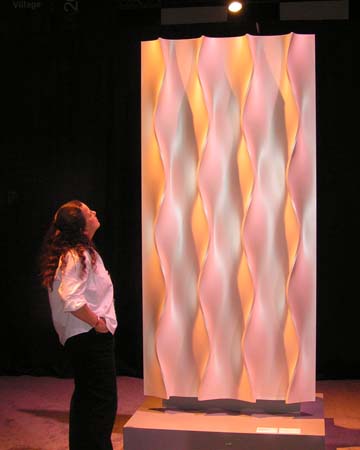
In the past SIGGRAPH has introduced me to some of the most interesting people and technology, and indeed it was the driving force for reference material as I completed an MFA-IA that focused on Art and Technology.
My thoughts on SIGGRAPH and Technology
I thought this might be a good opportunity to posts articles that relate to some of the topics at SIGGRAPH and art and technology that I have written in the past. I’ll also list my focus for my up and coming SIGGRAPH trip. If you know of a booth or an artist I should visit, please let me know. At this moment, I am not coming as press, but an attendee, unless someone needs an article or two from the conference, I’d be happy to oblige. My exploration at SIGGRAPH will still be as press, for my freelance articles and podcasts, as well as for a book I have been working on about Art and Technology. I’m just not working in an “official” SIGGRAPH Press capacity, unless someone contacts me to do so between now and SIGGRAPH.
Previous Articles and posts about SIGGRAPH Topics
Mongeon, Bridgette. “Review Pixologic ZBrush 4 Packed with features for both Mac and Windows Users.”
Studiodaily (November 2010) 30. pdf
Mongeon, Bridgette. “Exploring Digital Technologies as Applied to Traditional Sculpting.”
Sculpture Review. (Winter 2007) 30. pdf
Mongeon, Bridgette. “The American.”
Sculpture Review. (Winter 2007) 32. pdf
Mongeon, Bridgette. “Using the Computer and Poser in the Sculpture Studio.”
Best of Artists and Artisans online. (May2008)
Mongeon, Bridgette. “A Review of New Technology for the Traditional Studio at the Siggraph Convention.”
Best of Artists and Artisans online . (November 2008)
Mongeon, Bridgette. “Milling-An Additional Tool of Advanced Technology For the Traditional Sculptor.”
Best of Artists and Artisans online. (January 2009)
Mongeon, Bridgette. “Frankensteinian Art ”
Creative Endeavors. (May 2010)
Mongeon, Bridgette. “Antiquities, Masterpieces, Rights of Ownership and 3D Scanning”
Creative Endeavors. (May 2010)
Books
Bridgette Mongeon, contributing author. Digital Sculpting with Mudbox: Essential Tools and Techniques for Artists. Focal Press 2010.
Book Chapters
Bridgette Mongeon, contributing writer. “A Brief History of Medical Illustration.” The Digital Biomedical
Illustration Handbook. Author de la Flor, Mike: Charles River Media, 2004.
Podcasts about Art and Technology
Besides writing articles I also have an Art and Technology podcast that I began during my graduate work. I am very interested in reviving these podcasts now that Graduate school is over. I’ll enjoy once again having that “fire side chat” with others in the industry.
You can see a list of the Art and Technology Podcasts on my other website Digital Sculpting.net or your open the player and begin to listen
My interests for stories and interviews for SIGGRAPH-
Please note: Conferences are busy places. We can meet at SIGGRAPH and set up a time outside of SIGGRAPH to interview further.
- Anything relating to digital sculpting- software, hardware etc.
- Output- rapid prototyping advancements, milling, holographic imaging etc.
- Art and technology-artists and processes
- Scanning
- Robotics
- Antiquities and 3D
- Education of 3D and especially STEAM
- Papers relating to psychology and the process of creating in 3D
- There is always something new that I get so excited about when I go to SIGGRAPH-what is the cool new thing that will thrill me this year?
Here is a look at a video I found on SIGGRAPH Emerging technologies.





